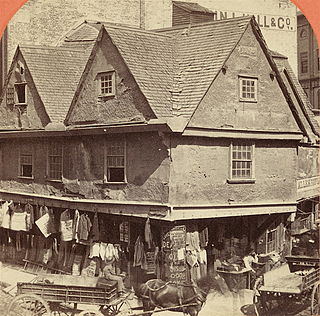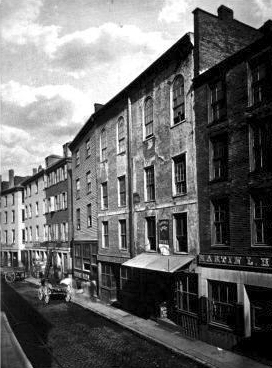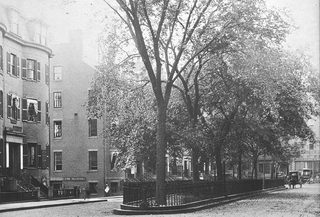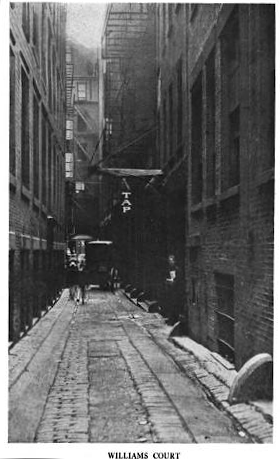
Faneuil Hall is a marketplace and meeting hall located near the waterfront and today's Government Center, in Boston, Massachusetts. Opened in 1742, it was the site of several speeches by Samuel Adams, James Otis, and others encouraging independence from Great Britain. It is now part of Boston National Historical Park and a well-known stop on the Freedom Trail. It is sometimes referred to as "the Cradle of Liberty".

Quincy Market is a historic building near Faneuil Hall in downtown Boston, Massachusetts. It was constructed between 1824 and 1826 and named in honor of mayor Josiah Quincy, who organized its construction without any tax or debt. The market is a designated National Historic Landmark and a designated Boston Landmark in 1996, significant as one of the largest market complexes built in the United States in the first half of the 19th century. According to the National Park Service, some of Boston's early slave auctions took place near what is now Quincy Market.
Washington Street is a street originating in downtown Boston, Massachusetts, which extends southwestward to the Massachusetts–Rhode Island state line. The majority of its length outside of the city was built as the Norfolk and Bristol Turnpike in the early 19th century. It is the longest street in Boston and remains one of the longest streets in the Commonwealth of Massachusetts. Due to various municipal annexations with the city of Boston, the name Washington Street now exists 6 or more times within the jurisdiction(s) of the City of Boston.

The Boston National Historical Park is an association of sites that showcase Boston's role in the American Revolution and other parts of history. It was designated a national park on October 1, 1974. Seven of the eight sites are connected by the Freedom Trail, a walking tour of downtown Boston. All eight properties are National Historic Landmarks.

Peter Faneuil was a wealthy American colonial merchant, slave trader and philanthropist who donated Faneuil Hall to Boston.

Tremont Street is a major thoroughfare in Boston, Massachusetts.

State Street is one of the oldest and most historic streets in Boston, Massachusetts, United States. Located in the financial district, it is the site of some historic landmarks, such as Long Wharf, the Old State House and the Boston Custom House.

The Old Feather Store (1680–1860) was a shop located at Dock Square and North Street in Boston, Massachusetts, in the 17th–19th centuries. It was also called the Old Cocked Hat. Built in 1680 by Thomas Stanbury, it was demolished in 1860.

The Massachusetts Charitable Mechanic Association (est.1795) of Boston, Massachusetts, was "formed for the sole purposes of promoting the mechanic arts and extending the practice of benevolence." Founders included Paul Revere, Jonathan Hunnewell, and Benjamin Russell. Through much of the 19th century, the association organized conferences and exhibitions devoted to innovation in the mechanical arts.

Hanover Street is located in the North End of Boston, Massachusetts.

Brattle Street, which existed from 1694 to 1962, was a street in Boston, Massachusetts located on the current site of City Hall Plaza, at Government Center.

Congress Street in Boston, Massachusetts, is located in the Financial District and South Boston. It was first named in 1800. It was extended in 1854 as far as Atlantic Avenue, and in 1874 across Fort Point Channel into South Boston. Today's Congress Street consists of several segments of streets, previously named Atkinson's Street, Dalton Street, Gray's Alley, Leverett's Lane, Quaker Lane, and Shrimpton's Lane.

North Street in the North End of Boston, Massachusetts extends from Congress Street to Commercial Street. It runs past Dock Square, Faneuil Hall, Quincy Market, the Rose Kennedy Greenway, and North Square. It was first named in 1852, and consists of segments of streets formerly named Ann, Fish, Ship, Drawbridge, and Conduit Streets.

Merchants Row in Boston, Massachusetts, is a short street extending from State Street to Faneuil Hall Square in the Financial District. Since the 17th century, it has been a place of commercial activity. It sits close to Long Wharf and Dock Square, hubs of shipping and trade through the 19th century. Portions of the street were formerly known as Swing-Bridge Lane, Fish Lane, and Roebuck Passage.

Pemberton Square in the Government Center area of Boston, Massachusetts, was developed by P.T. Jackson in the 1830s as an architecturally uniform mixed-use enclave surrounding a small park. In the mid-19th century both private residences and businesses dwelt there. The construction in 1885 of the massive John Adams Courthouse changed the scale and character of the square, as did the Center Plaza building in the 1960s.

Pi Alley in Boston, Massachusetts is located off Washington Street, near the Old City Hall on School Street. The origin of the short street's name remains in question. It may be named after the pied type which newspaper composing rooms dumped into the alley in the past, or after the local restaurants that sold coffee and a piece of pie for a nickel. It is also known as Williams Court, Savage's Court, Peck's Arch, and Webster's Arch.

Francis Jackson (1789–1861) was an abolitionist in Boston, Massachusetts. He was president of the Massachusetts Anti-Slavery Society for many years, was also president of the New England Anti-Slavery Conventions, and vice president of the American Anti-Slavery Society. He was also affiliated with the Boston Female Anti-Slavery Society and the Boston Vigilance Committee. He worked for the South Cove Corporation, filling in land in Boston's South End in the 1830s.


A Once and Future Shoreline is a permanent public artwork that graphically marks the edge of Boston Harbor, circa 1630, into the granite paving blocks of the plaza on the West side of the historic Faneuil Hall building. The 850-foot-long artwork depicts the location of a pre-colonial shoreline by graphically etching silhouettes of materials that are found typically along the high tide line. The artwork offers a way to engage the imagination in an exploration of the changes to this now urban site from a salty tidal marsh, to an active pedestrian plaza.
Morgan, Edmund S., The Puritan Dilemma The STory of John Winthrop, Harper Collins, 1958.































